 |
 |
 |
| |
CUSTOMIZE: OVERALL RESULTS FROM A HYBRID III IMPLEMENTATION-EFFECTIVENESS STUDY EXAMINING IMPLEMENTATION OF CABOTEGRAVIR AND RILPIVIRINE LONG-ACTING INJECTABLE FOR HIV TREATMENT IN US HEALTHCARE SETTINGS; FINAL PATIENT AND PROVIDER DATA
|
| |
| |
IAS 2021 July 18-22
Maggie Czarnogorski,1 Cindy Garris,1 Ronald D'Amico,1 Jason Flamm,2 Gary Sinclair,3 Michael Wohlfeiler,4 Leandro Mena,5 Marybeth Dalessandro,6 Colleen McHorney,7 Sonal Mansukhani,7 Will Williams,8 Deanna Merrill,1 William Spreen1
1ViiV Healthcare, Research Triangle Park, NC, USA; 2Kaiser Permanente Sacramento, Sacramento, CA, USA; 3Prism Health North Texas, Dallas, TX, USA; 4AIDS Healthcare Foundation, Los Angeles, CA, USA; 5University of Mississippi Medical Center, Jackson, MS, USA;
6ViiV Healthcare, Collegeville, PA, USA; 7Evidera, Bethesda, MD, USA; 8GlaxoSmithKline, Collegeville, PA, USA
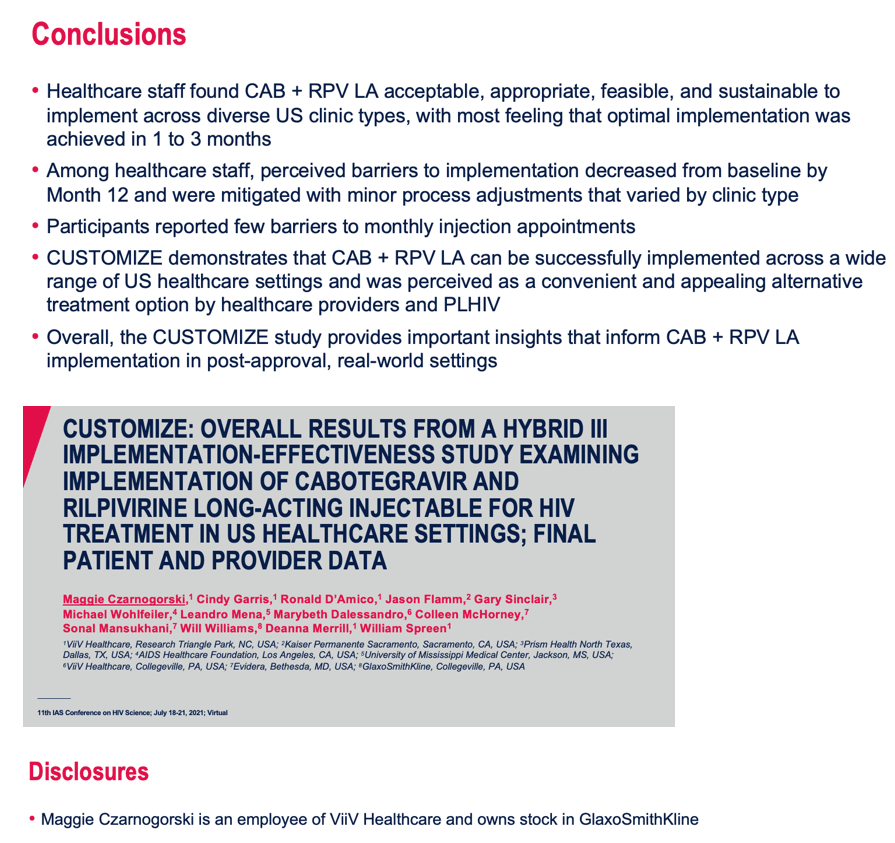
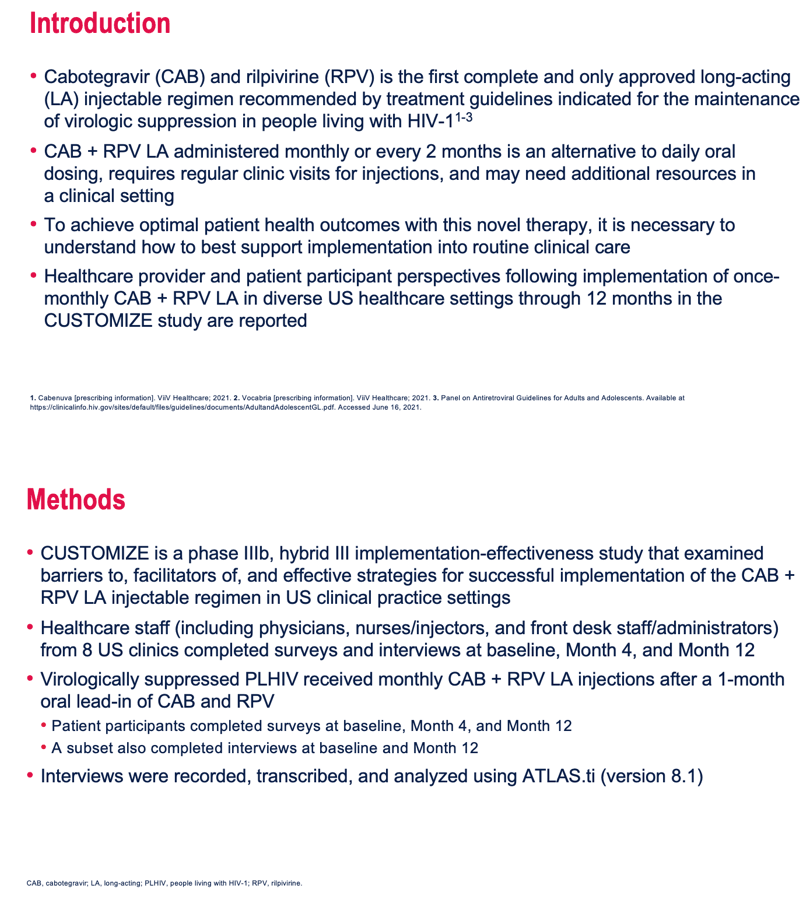
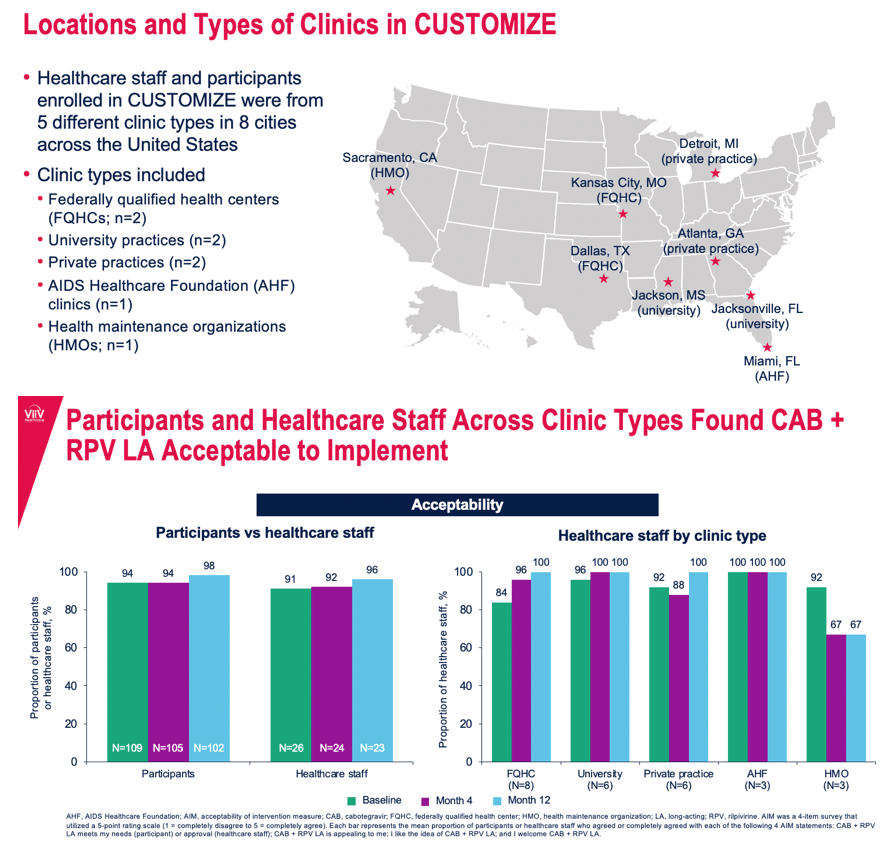
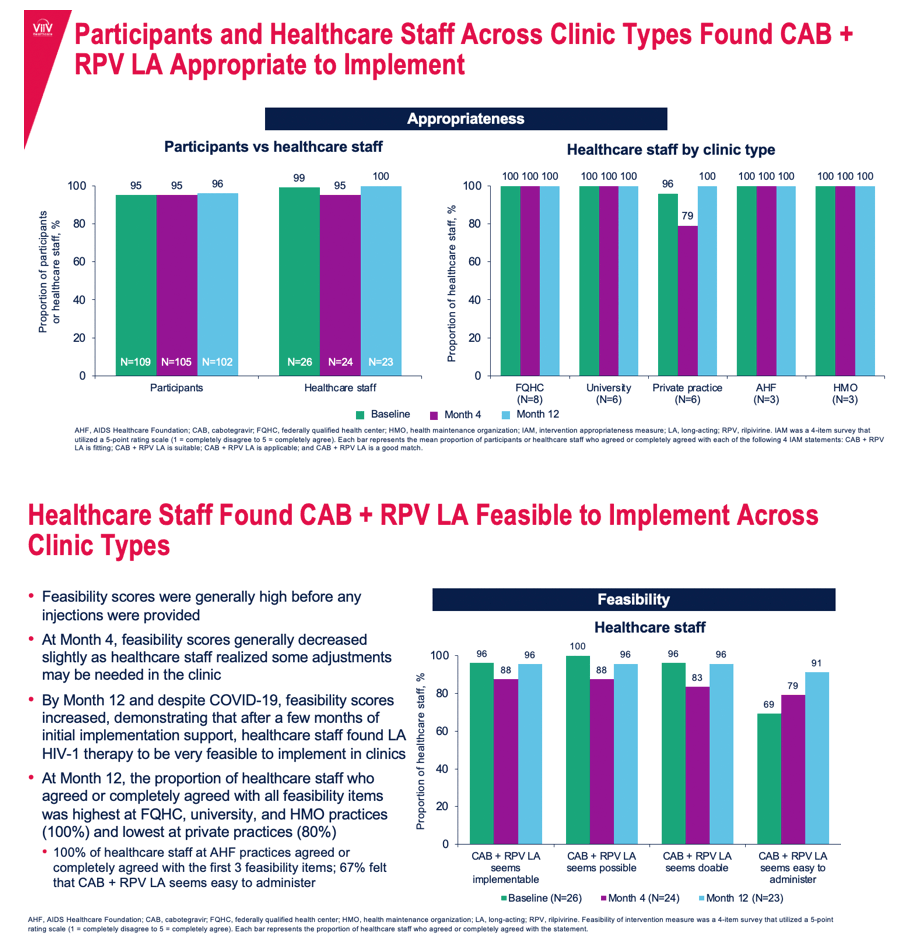
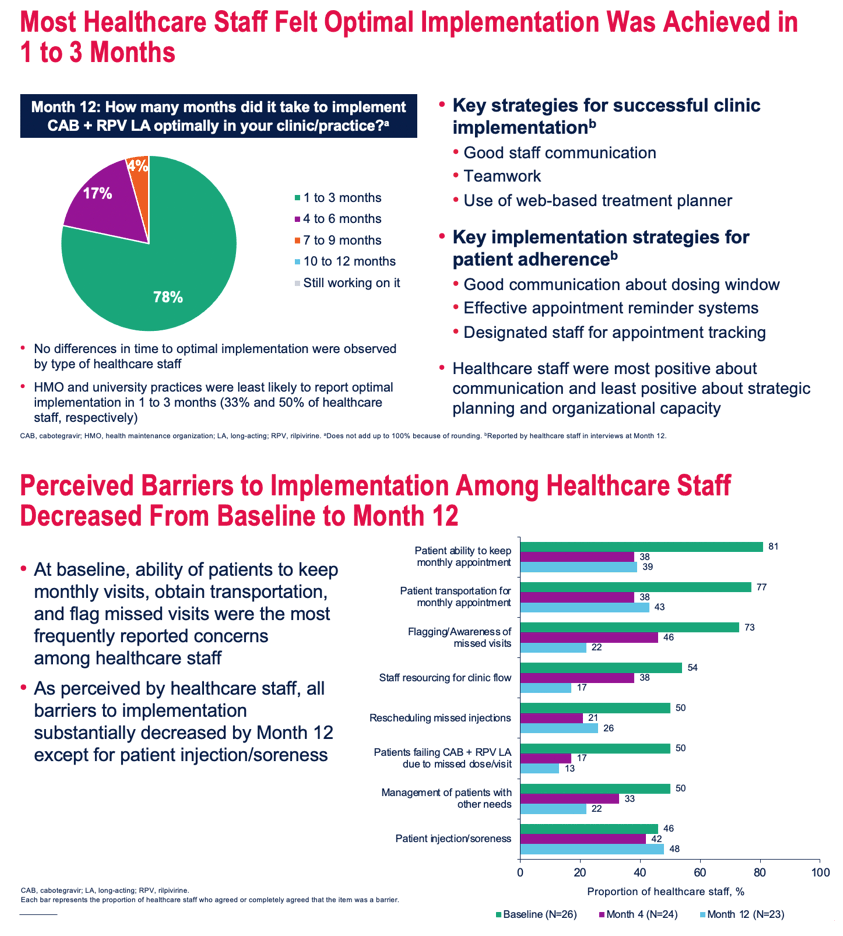
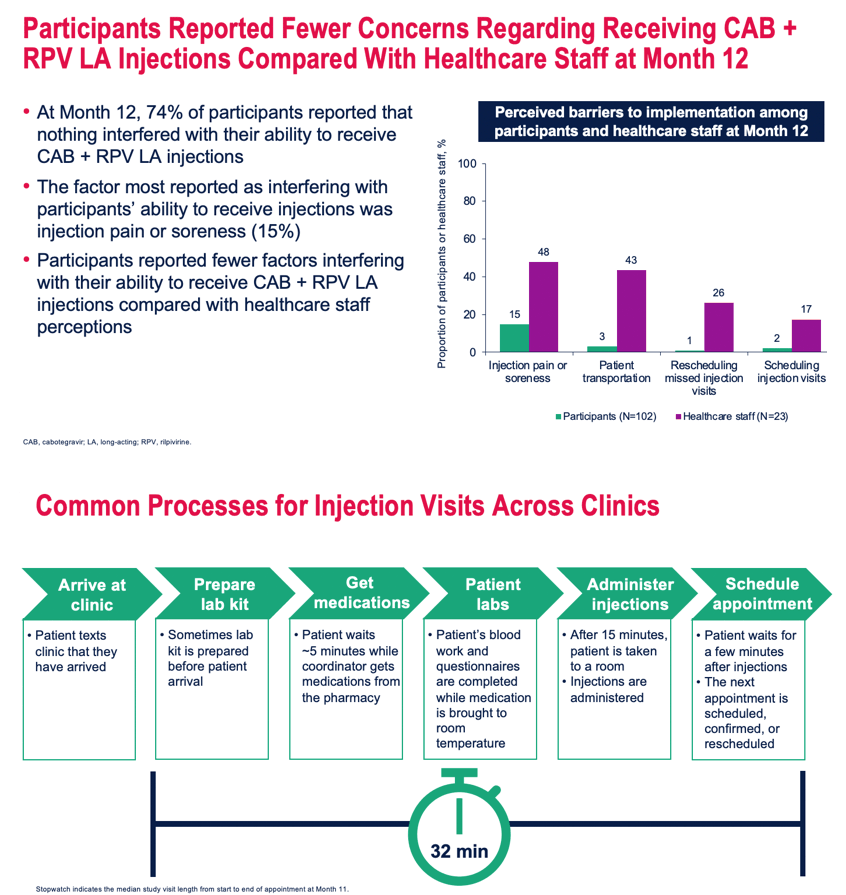
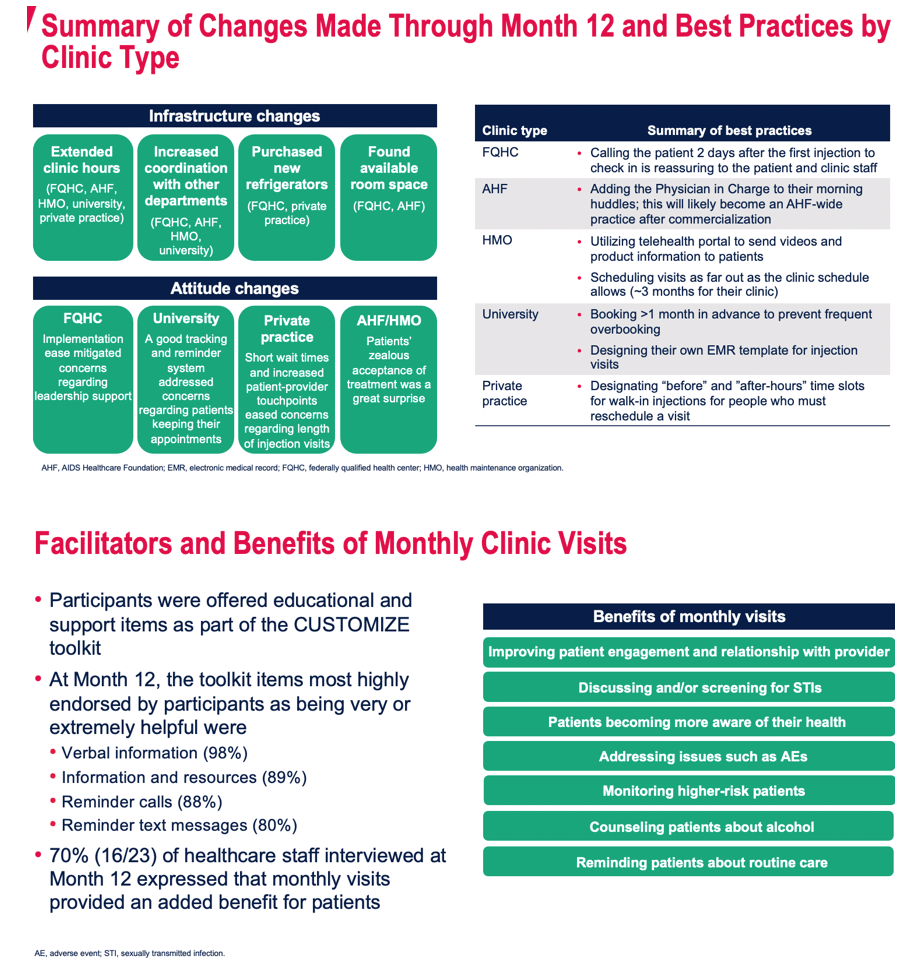
FQHC: One FQHC physician noted that, post-commercialization, CAB LA + RPV LA patients will be triaged in a designated room and not a general exam room. The office administrator confirmed that patients walk into the clinic and go to the labs to get their blood drawn. Since their lab does not have an examination table, patients were then taken to a different room where they lay down and receive the injections. Their vitals were also taken in the room where injections were administered. One FQHC office administrator reported that the wait time was minimal (<5 minutes) as part of CUSTOMIZE. However, they did mention that once research patients convert to "regular" patients, they may have to wait longer because SSPs get delayed. Another FQHC SSP concurred with the wait time being minimal and less than five minutes. Both FQHC sites concurred that they try to do the remaining activities while the patient is waiting.
010103 (FQHC Office Administrator): "Yeah. So we try to do everything else while the kit is warming up, so get the vitals, get everything else, draw labs, everything like that so we're not just like sitting there for 15 minutes waiting. But there are times they're like oh no, everything's fine, and we get their vitals and they don't need labs because you don't do labs every visit on this study, they might be sitting there for a while waiting for it to warm up."
Private practice: Both private practice sites mentioned that the patients waited for about five minutes in the waiting room and about 10 minutes in the exam room.
University: One university site mentioned that as the patients for CUSTOMIZE arrived at the site, they typically texted the office administrator and only had to wait for a few minutes before their labs were drawn and vitals were done. Both university sites mentioned that the wait times can be longer with one university SSP mentioning up to 25 minutes for a "regular" non-CUSTOMIZE visit. They did mention that, as part of the protocol, they had to observe the patient for 20 minutes after the injection.
020102 (University Injector): "No, because most of the time like I say, if they text us and say that they're on the way or that they're, you know, parking, we'll go ahead and pull the medication out. Most of the time it's actually just observation." INTERVIEWER: "Okay. And how long would you observe them?" 020102: "Um, the protocol made us do 20 minutes but that's typically the standard of care as well." INTERVIEWER: "Okay. And while you were observing them, were patients by themselves in the exam room or were you hanging out and chatting with them?" 020102: "We - we - we were in there with them."
HMO and AHF: The HMO site injector also said that patient wait time was no more than five minutes and walked the interviewer through the entire process as mentioned in the quote below. The site physician mentioned that, unlike other sites, they think that a regularly-scheduled visit post-commercialization would also be quick as long as the patients are informing them ahead of time about their arrival and, thus, indicating to the staff to warm the drugs for injections. The AHF site also mentioned that their patients are able to text them before arriving and they barely have to wait in the waiting room before they are taken to the exam room where injections are administered. The AHF physician mentioned space was a little bit of an issue.
Medication Preparation and Administration: Most sites expressed that they anticipate the patients coming in for their appointment. For one university site, the injector or the research coordinator must receive a sign-off from the physician to get the injections from the pharmacy. The university physician said that they like to prepare ahead of time and sign-off on the medication "procuring" requests before the patient arrives. However, the pharmacy still has to receive these orders when the patient officially signs in; only after this process does a pharmacy technician come to the clinic to deliver the medications to the injector. The time is logged at the time the medications are taken out of the refrigerator. The university physicians expressed that their interactions with the pharmacy have been "not too bad." Sometimes the pharmacy took time to get the medications delivered to them, but usually they were prompt.
FQHC sites expressed that when a patient checks in to the clinic, the first thing they do is take out the medication from their refrigerator. As part of CUSTOMIZE, the pharmacy stocks their own refrigerators with the CAB LA + RPV LA kit, and the injector or the office administrator takes out the kit and thaws it while the patient waits and does other activities. If the pharmacy is external, the pharmacy pick-up appeared to be pretty seamless as noted by FQHC in the quote below.
Private-practice sites have their own refrigerator where they store their medicines, so they do not need to interact with a pharmacy. One private-practice site mentioned that their patients are very good about letting them know when they have left home and if they are going to be late for their appointment which helps them to manage the time it takes to thaw the medication before the patient arrives.
Much like the private practice, the AHF site also has their own refrigerator on-site, but the office administrator, rather than the injector, was responsible for checking the inventory and taking out the kit in time to thaw before the patient arrives. The injector's role was only to administer the injections. The HMO site used a combination of their own refrigerator and the refrigerator in the local pharmacy. They maintain eight doses in their own clinic refrigerator and store the rest of the kits in the pharmacy refrigerator. Post-commercialization, the HMO injector said that it might be an inconvenience to go to the pharmacy every time to get the injection kits because of the potential volume of patients, and they might have to invest in one more refrigerator and additional space to locate the kits more "in-house."
The conversations sometimes have a component of injection-site pain or questions about the injections being prepared, but these were more common during the first few months of CUSTOMIZE. By month 12, SSPs expressed that the patients just "hop and go."
Scheduling Next Appointment and End-Of-Visit, Patient Questions: Sites scheduled next injection appointments at various times—sometimes when the patient was waiting for the injections to thaw and be prepared, sometimes right after lab work, and sometimes toward the end of the visit. One FQHC site scheduled appointments one month ahead while the patient was in the office and usually during lab work. The office administrator r at the FQHC gave them options and date ranges for the next appointment and patients were either handed a card (if they want to take one) or typically they seemed to be happy with the text-messaging reminders. Interestingly, the physician from the same FQHC site thought that the appointments were scheduled two to three months in advance. The private practices scheduled the next appointment at check-out. However, sometimes if the patient was waiting for long periods of time, they may have scheduled before the injections were administered. The university sites and the HMO also scheduled the next monthly appointment at the end of the injection visit—the difference being that the office administrator scheduled the appointment at the university sites and the injector managed this at the HMO.

|
| |
|
 |
 |
|
|